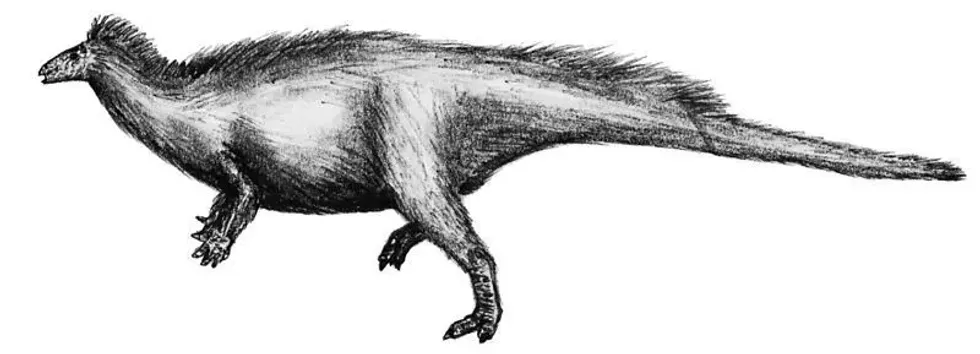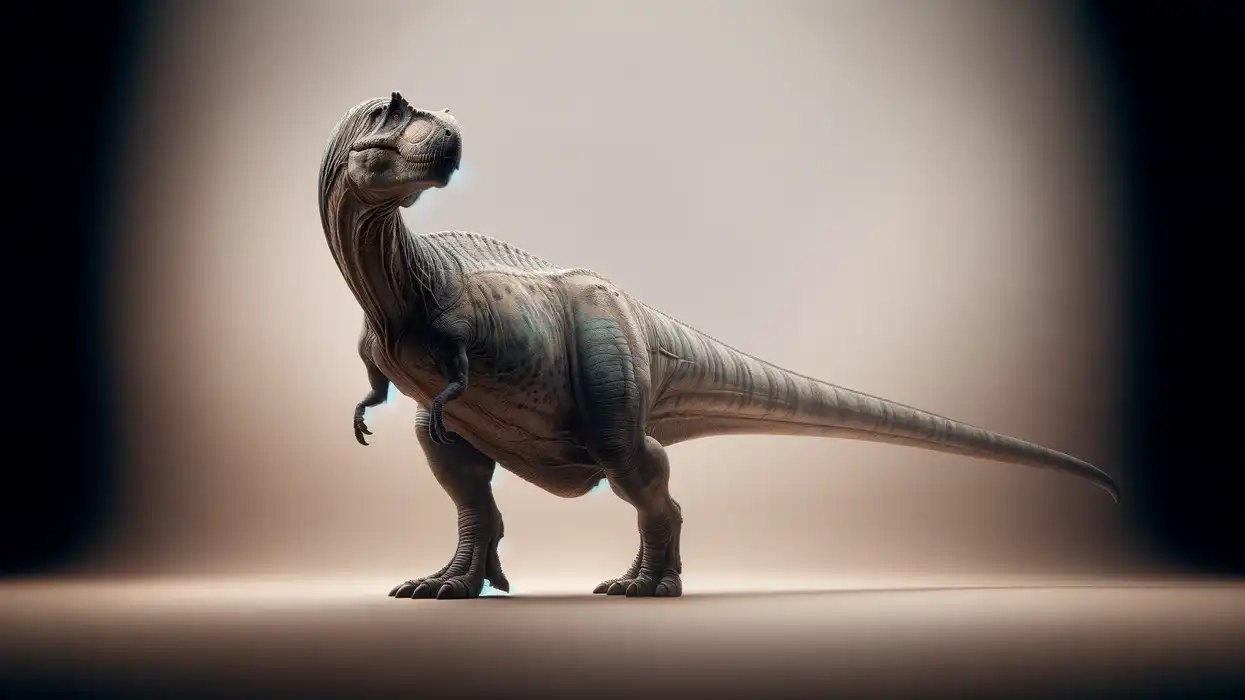Camptosaurus was a large hadrosaurus dinosaur that lived in the Jurassic Period of North America several million years ago. It was a flexible lizard whose remains were discovered by Marsh in 1989.
The name is derived from the Greek words 'kamptos' and 'saurus,' meaning 'bent lizard.' The length was about 23 ft (7 m) and the height was nearly 4 ft (1.22 m).
It had a horny beak in front of its mouth that lacked teeth but was utilized to eat vegetation. The skull was triangular. Iguanodon was a distant relative of Camptosaurus and had a unique spike-thumb.
The complete classification of Camptosaurus is as follows: Dinosauria, Ornithischia, Genasauria, Ornithopoda, Euornithopoda, Iguanodontia, and Ankylopollexia. Camptosaurus colors have been assumed to be dark red or brown with black lines.
A discovery made states that this dinosaur could walk on two legs (bipedal) or on four legs (quadrupedal) with small hooves at the end of each toe. Most of the specimens are placed in museums in regions where they were found.
The specimens have been found in Wyoming and various other regions of North America and Europe. It was first found and named Camptonotus meaning, 'bent back,' which later changed to the bent lizard.
They were ornithopod dinosaurs who may have lived in short groups. As a herbivore, the diet was mainly constituted of plants.
To know more about dinosaurs, you can also check out these harpactognathus facts and austroraptor facts.
Camptosaurus Interesting Facts
How do you pronounce 'Camptosaurus'?
Camptosaurus pronunciation is 'Camp-te-saw-rus'. The Camptosaurus name has been derived from two Greek words, kamptos and sauros, meaning bent lizard or flexible lizard.
What type of dinosaur was a Camptosaurus?
Camptosaurus was a genus of ornithopod herbivore iguanodon dinosaur, where discovery states that they lived during the Late Jurassic Period, what we have now known as North America. It belonged to the suborder Ceropoda and clad Ornithopoda.
The name Camptosaurus means 'flexible lizard,' which is derived from the Greek words 'Hamptons,' meaning 'bent' and 'sauros', meaning 'lizard.' Therefore, it is also known as the bent lizard. The main type species was Camptosaurus dispar which was named by Marsh in 1879.
In which geological period did the Camptosaurus roam the earth?
The Camptosaurus lived in the Late Jurassic Period, around 145-156 million years ago.
When did the Camptosaurus become extinct?
The Camptosaurus became extinct about 156 million years ago.
Where did a Camptosaurus live?
The dinosaur Camptosaurus lived in what is now called Europe and North America.
What was a Camptosaurus's habitat?
Camptosaurus remains were found in Europe and North America. For the first time, the dinosaur was found in Utah, USA, by Earl Douglass.
C. Marsh gave the name to the dinosaur in 1885. Many specimens of this dinosaur were found in numerous stages of growth and development. Their habitat was assumed to be shrublands and other areas rich in vegetation.
Who did a Camptosaurus live with?
The Camptosaurus may have lived in tiny groups. The number of individuals in a Camptosaurus herd was based upon the quick movement and speed to rescue itself from predators.
How long did a Camptosaurus live?
The life span of the Camptosaurus has been unknown.
How did they reproduce?
Little is known related to the reproduction of these dinosaur species. A fossilized Camptosaurus embryo of about 9 in (22.86 cm) was found from Morrison Formation strata which are now placed at Dinosaur National Museum in Utah.
Camptosaurus Fun Facts
What did a Camptosaurus look like?

The Camptosaurus was a small dinosaur with robust hindlimbs and wide feet consisted of four toes. The specimens of Camptosaurus dispar, from Quarry 13, were discovered from deep layers of earth, probably dating to the Callovian-Oxfordian.
The larger fragments of the Camptosaurus skeleton indicated that the dinosaur was about 26 ft (7.9 m) long and nearly 6.6 ft (2 m) at the hips.
They would have been reached a height of about 19.7 ft (6 m) and a weight of nearly 2,204.62 lb (1000 kg). Gregory S. Paul estimated a much lower length of 16.40 ft (5 m) and a weight of 1000 lb (453.59 kg).
Prior reconstructions, including those of Gilmore and Marsh, were dependent on the Theiophytalia skull and showed a wrong, more rectangular profile. In fact, the skull was triangular, with a sharp snout and a beak.
The teeth of the dinosaur were more compactly packed in the jaw relative to other Euornithopods. Museum curator John Foster described the dinosaur teeth as 'thick ridges on the sides and fine teeth on the edges.
These features were the same as Dryosaurus but more fully developed. The Camptosaurus' teeth usually displayed extended wear, which designated that the dinosaurs had a comparatively tough plant diet. The Camptosaurus skin type has been unclear.
Camptosaurus dinosaurs were probably huge creatures with strong hindquarters and broad legs that allow them to keep their bodies upright. In addition, these dinosaurs had a large nose, horny beak, and many teeth, which probably helped break through tough plant material.
How many bones did a Camptosaurus have?
The exact number of bones in the dinosaur, Camptosaurus, has not been defined in total. However, the bones of the Camptosaurus embryo were found without any eggshell fragments.
The Camptosaurus bones were more coarse in surface texture than those of an adult dinosaur. It would probably be damaged the spinal cord when wandering around if these bones were never combined.
These features are possessed by every dinosaur embryos around the world. In 1965, the skeleton of the dinosaur was displayed at the museum.
Basically, it was mounted in the pose of a kangaroo on its back legs and used its tail as an aid. However, in 2013, it was mounted again into the latest four-legged pose.
This skeleton in the museum is about 17 ft (5.18 m) long and 5 ft (1.52 m) in height at the hips. It is a cast of bones made of plaster of Paris collected from the Cleveland Lloyd Dinosaur Quarry, approximately a distance of 30 mi (48.28 km) south of Price.
It was a distant cousin of Iguanodon, the dinosaur with a thumb-spike. This thumb had tiny movement and the claw was like a spike. It was thought to be a bipedal dinosaur, using its long tail that constituted around 50 % of its entire length as a counterbalance, just like in Allosaurus.
Despite the supportive tail, it appeared doubtful that the Camptosaurus was a bipedal dinosaur because of the massive front body that accommodated a large stomach. Therefore, it was concluded that it was too front-heavy to walk on back legs.
The Camptosaurus skull was roughly 55 in (139.7 cm) long. It did not possess front teeth in the beak and wide teeth in the cheeks. The teeth were made stronger by elevations on the outer surface.
These teeth helped to pulverize vegetation. The pelvis had a wider length and the ilium bowed outwards.
The hand had five digits. Although, only finger numbers one, two, and three had claws. This made the hand an ideal weight-bearer but worthless for grabbing plants.
How did they communicate?
Camptosaurus dinosaurs could be communicated through their voices and body movements. Camptosaurus sounds were assumed to be of a moderate pitch.
How big was a Camptosaurus?
Camptosaurus was nearly 275.59 in (700 cm) long and had a height of 4 ft (1.22 m), which is 3 times larger than a horse.
How fast could a Camptosaurus move?
Camptosaurus dinosaurs could walk on two or four legs. The Camptosaurus speed was probably 15 mph (24.14 kph).
How much did a Camptosaurus weigh?
The total weight of Camptosaurus has been estimated to be around 2000 lb (1000kg). They weigh 5 times heavier and are bigger than grizzly bears.
What were the male and female names of the species?
No specific names were given to male and female Camptosaurus species, separately.
What would you call a baby Camptosaurus?
The baby Camptosaurus would be known as a young, hatchling, or nestling.
What did they eat?
Camptosaurus dinosaurs were herbivorous whose diet was mainly based on plants. Some of the plants probably included conifer needles, ferns, clubmosses, ginkgo, and horsetails.
How aggressive were they?
No information has been published about the aggressiveness of Camptosaurus dinosaurs.
Did you know...
Some other species in the Camptosaurus genus include C. prestwichii, C. leedsi, and C. depressus. C. aphanoecetes is the latest species described by Ken Carpenter, 2008.
The name of species aphanoecetes is derived from the Greek word 'aphanoe,' which means 'hidden,' and 'cetes,' meaning 'to dwell'. This species specimen is placed at the Carnegie Museum for more than 75 years as a mounted skeleton.
What time period did the Camptosaurus live in?
Camptosaurus dinosaurs lived in the Late Jurassic period, about 145-156 million years ago.
Was Camptosaurus bipedal?
It was believed to be a bipedal dinosaur, but later it was discovered that it probably be quadrupedal.
Here at Kidadl, we have carefully created lots of interesting family-friendly dinosaur facts for everyone to discover! Learn more about some other dinosaurs from our Chungkingosaurus facts and Homalocephale facts pages.
You can even occupy yourself at home by coloring in one of our free printable Camptosaurus coloring pages.









